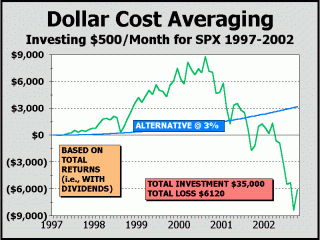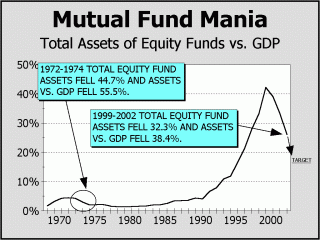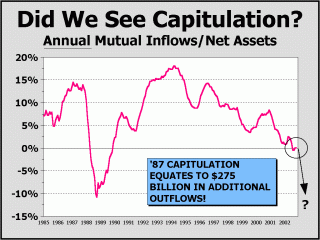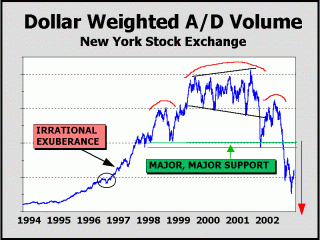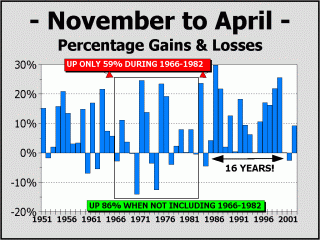
|
CHART DATA COMPILED THE WEEK OF NOVEMBER 4-8, 2002 A SPECIAL REPORT BY ALAN M. NEWMAN, EDITOR LONGBOAT GLOBAL ADVISORS CROSSCURRENTS |
| We wrote last
time that, ".....history has shown that bear markets do not end until most
investors believe they will never end, far from the attitude displayed
by most professionals." If there is one salient fact about the current
bear market, it is that the attitude of professionals has not changed its
course from the very beginning of the stock market mania. The premise
of a stock asset bubble was never accepted. The premise that a bubble
could burst was never accepted. The premise that a new bear market
had commenced was never accepted.
These circumstances certify this bear market as unique in all of history. Thus, we are probably correct in assuming the mania was and still is the biggest mania of all time. If so, it may be entirely logical to assume that the biggest stock market mania of all time should be followed by the worst bear market of all time. However, the notion of "worst" is dependent upon three factors; price or time or both. Thus far, the current bear market is not in first place in any of the three categories. But as long as the bear market remains unique in those regards mentioned above, the greater the odds will be that the bear will eventually reign as the worst of all time. With the holidays closing in, we thought it approriate to offer a reading list of the best books we have found to illustrate the environment. We believe they will present perspectives well worth your time.
Despite the loss of $7.5 trillion in wealth, Americans are still fascinated by stocks. Amazingly, the velocity of trading continues at levels well in excess of the Roaring Twenties. For every dollar generated in Gross Domestic Product, $1.77 is currently traded in the stock market versus $1.33 in 1929. And clearly, the 1920's represented a veritable stock market mania. The stories you have heard are all true. Read for yourself in Once in Golconda: A True Drama of Wall Street 1920-1938 by John Brooks (ISBN#0471357529). Brook's treatise is the most comprehensive study of the time and stands out for its relevance to the present day. In the words of the Saturday Review, "It's all there......the avarice of an era that favored the rich; and the later anguish of myriads of speculators doomed by a bloated market, easy credit and their own cupidity and stupidity," words that could easily be written again about the current era should a similar fate befall us. There is one huge difference, of course. In the prior era, the dominant psychology changed from greed to fear as it always has done before when prices have collapsed. But not this time. Wall Street's propaganda mill has accomplished the impossible - a bear market unaccompanied by fear - only the resolute acceptance that patience alone is all that is required to bring about a brand new bull market. What is at risk is
that the circumstances
Given the annual changes in total stock market capitalization versus GDP visible below, it is difficult to imagine a dénouement any different than what occurred after the 1929 market crash. In fact, in terms of lost wealth, the current outcome thus far appears worse than it was in the prior era. Despite the obvious; that $7.5 trillion in wealth had to be created before it was destroyed, does not place us back at square one. It places us further back on the path to economic well being than we were before. Consider that as the perception of potential wealth expanded on paper, those blessed with such potential spent at least a significant portion of said potential. Consider that as prices surged to levels that implied the permanence of rising prices, those blessed with stocks actually spent a significant portion of their future, as clearly illustrated by the growth of margin loans, home equity lines of credit, and credit card advances. In the case of margin loans, their impact versus the entirety of GDP was greater than anytime since 1929. In the case of IRAs, 401k and other pension accounts, the assumed assurance that funds would subsequently be there when one retired became an impetus to spend in the present. And as a result, much of the 4.8% annualized economic growth generated during the mania from 1995-2002 may have stemmed from assumptions that were way too optimistic. Unless stock prices can once again soon reassure the investing masses of the permanence of gains, the reality of the destruction of so much wealth will eventually take its toll on the psychology of investors and their approach to savings. The odds greatly favor that investors will turn to far more conservative approaches to saving in the future.
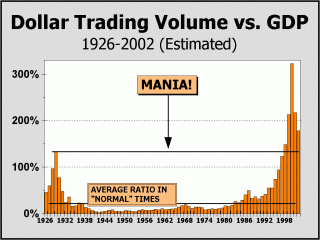 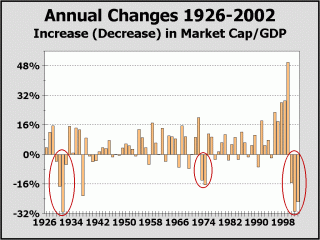 The long term mantra. "Buy and hold." Who hasn't heard it? Trouble is, Wall Street's old familiar line and "virtually guaranteed" strategy does not always work, unless you have the patience of a saint. And even then, your patience could be painfully tested. And even then, you might wonder what if instead you had sold out when everyone else was giddy and prices were high? The truth that Wall St. does not ever want you to hear is that stocks do indeed go down for protracted periods from from time to time. Proof? See the last chart of our archived report of April 2002, "Time Will Tell." One also need look no further than how the "virtually guaranteed" strategy of Dollar Cost Averaging has worked since January 1997, a period of five years and ten months. Using DCA, one buys more stock when prices are low and less stock when prices are high, a seemingly brilliant way of facilitating the logic of "buy low, sell high." The problem of course, is that using DCA or buy-and-hold, one never sells! As a result, gains are merely tentative and are only "on paper." Investing $500 (for example) each and every month in the S&P 500 certainly did quite well for awhile as the mania unfolded, but it is clear than an alternative and conservative course of action would have turned out a lot better to date. The current mania has been constructed upon the foundation of mutual fund investments. Funds are the easy way to play the market, both for individuals and for their IRAs and 401Ks. Let the professionals do the legwork of investing your money. When the mania commenced in 1995, there were only 1600 stock mutual funds around. Today, there are more than 4800 stock funds and believe it or not, September 2002 witnessed a new record in the number of funds! The rate of growth in funds is an astounding 16.9%, even greater than the growth in the Dow from where we measure the inception of the madness in January 1995. In the process, the fund business boomed exponentially, enriching fund managers and shareholders of the fund companies. To this effect, it has been more important to keep the illusions of enriching investors alive, rather than managing their risk. How else could Fidelity Magellan, the world's largest mutual fund, have only 0.5% of its assets in cash only three trading sessions past July 24, 2002, when the traded to a print low of Dow 7532, the lowest the Dow had traded since October 1998?! If we are correct in our assessment that the field has been completely flooded with those whose advice and performance has been less than profitable (read less than professional), then it stands to reason that growth will flatten and even turn negative in the next several years to come. We believe the target offered in our chart (below right) is conservative. This conservative target implies prices as low as Dow 6000.
Although prices did collapse into the September 2001 lows, we still do not believe we have seen anywhere near the kind of capitulation phase that would mark a definitive end to the mania. Simply put, history has shown over and over again that the bad times do not end until participants recognize the environment as horrible and without the possibility of change; and are prepared to sell stocks at literally any price. This is what drives prices to attractive long term levels and what catalyzes the potential for a new bull market. The proof is in Taming the Bear by Thomas Saler (ASIN: 1564403688). Head straight to Chapter 4, "Guessing Games," and read how the conventional wisdom from Wall St. is bearish at bottoms and bullish at tops. And then consider that Wall St. strategists have remained overwhelmingly bullish throughout the current bear market. Even investment advisers, with the exception of a few very brief weeks, have been overwhelmingly bullish even as prices tanked. This is so atypical of any past bear market! Capitulation on a par with 1987 would mean
a lot more to come
Our dollar weighted cumulative advance/decline volume measurement for the New York Stock Exchange is an example of the most massive head-and-shoulders type pattern we have ever observed. Although the pictured pattern does not precisely meet the textbook definition, it nevertheless provides a striking image of a succession of failing rallies. When the broadening top of higher highs and lower lows was broken significantly in the fall of 2001, major support was once again tested. But when the correction from the subsequent rally failure into early 2002 broke below our zone of "major, major support," the notion of support became invalid. We then placed our best measurement of EVENTUAL downside potential well below where the mania commenced in 1995. Given that the indicator has already broken below where Federal Reserve Chairman Alan Greenspan posed "irrational exuberance" at Dow 6437 in December 1996, we believe prices will eventually follow. There is certainly some chance that resistance levels will be tested. The best case for resistance is the former zone of major support. But even at current levels, upside potential is less than downside risk. If prices do move higher, then downside risks will increase accordingly.
[a portion of this commentary is derived from our article in the October 21st issue of Crosscurrents] Every six months, we look at the seasonal aspects that have ruled the market for more than five decades. [see our current commentary on this website] Simply put, since 1950 the stock market has LOST money for investors during the months of May through October, a period we have termed the "Dead Zone." These losses have averaged 0.3% per period. On the other hand, the period November through April has been responsible for gains of 15.9% per period, virtually every single penny and more of all stock market profits! Put another way, $10,000 invested in only the months of November through April has grown to $463,636. $10,000 invested during the Dead Zone is now worth only $8976. Why? We can only offer a few rationales, which probably account for this rather strange phenomenon. First and foremost, the evidence shows that cash inflows are higher during the good six months, most likely influenced by IRA and pension inflows and possibly, year end bonuses. Statistically, this is borne out by mutual fund inflows since mid-1990, which have averaged only $8.2 billion per month from May to October and $13.9 billion per month from November to April, a resounding 70% higher than during the Dead Zone period. Secondly, the seasonal weakness typically felt in September and October has been documented for years and has now conceivably become somewhat of a self fulfilling phenomenon all by itself. Although that notion will certainly be construed as controversial, it is clear that a vast consensus of observers are now pinning their forecasts on the typical October bear killing turn, positing at the very least, a 30% to 50% upside move over the next six to nine months. Given the extent of this consensus and how rapidly it has formed in recent weeks, we now have second thoughts. As we have pointed out ad nauseam, there are two important factors working against stocks at this time; the continued optimism of strategists and mutual fund cash levels, both absolute and relative. The pyschology that permits this type of consensus to exist and grow is detailed at length in Psychology and the Stock Market by David Dreman (ISBN: 0814454291). Even if stocks bottom in this time frame, can we now expect the same six to nine months of decent upside that we thought might be possible before? Given that even we now appear to be part of the vast consensus, we must doubt our own judgment! Looking more closely at the six month phenomenon, if investors are truly on the path to paring back the percentage of household assets devoted to stocks, perhaps November to April will not prove to be the wondrous environment all now seem to expect. In fact, it is quite clear that the good six months were not up to snuff in the last secular bear market, measuring from the first over-1000 Dow day in 1966 to the super bull's takeoff in 1982. As our chart illustrates, seven of the 17 periods were negative and throughout the periods, gains only averaged 4.5%. Gains during the good six months at times other than a secular bear market were worth two-and-a-quarter times as much. And since the bull market ended in 2000, the last three "good" six month periods have been flat, -2.5% and +9.2%, an average of +2.2%, not exactly what investors would consider inspirational. In fact, the consensus is also relying on the 3rd year of the Presidential Cycle, virtually flawless as far back as the eye can see and the best year of the cycle by far, averaging 18% gains. But even here, we see the impact of a secular bear market! Three of the pictured 13 years within the third year of the cycle stand out for paucity of gains, 1971, 1979 and 1987. The first two years were within the framework of a secular bear market. Despite the legitimate concern that there are no guarantees, a huge consensus now believes the third year of the cycle will bring about a bull market. That, and the arrival of the "good" six months have folks all worked up. The statistics of the 50 years would have you believe the year ahead, or at least the next six months will be rewarding on the long side. But even if every one of the past observable periods had resulted in gains of 30%, there is no proof that this period will also gain as well. In fact, Fooled By Randomness: The Hidden Role of Chance in the Markets and in Life by Nicholas Taleb (ISBN:1587990717) will show you why. The consensus view is meaningless. At the very top in 2000,
We see the same type of consensus now.
[a portion of this commentary is derived from our article in the October 7th issue of Crosscurrents] The statistics measuring the scope of derivatives are enough to make one's eyes bulge out in disbelief and horror. Given that we see financial earthquakes as unavoidable as the planetary kind, there is likely to be an inevitable disaster somewhere on the horizon. In fact, inevitable disasters have already occurred, and at least one has threatened the stability of the world's financial markets. For a glimpse of the first stage of a financial armageddon, read When Genius Failed: The Rise and Fall of Long-Term Capital Management by Roger Lowenstein (ISBN: 0375758259). That said armageddon has not yet taken place does not mean it never will. As today's charts clearly illustrate, derivatives appear larger than life itself. The total notional value of derivatives for U.S. commercial banks is now $50 trillion, an amount five times the country's stock market capitalization and five times gross domestic product. "Notional" does not represent capital at risk, just the total amount covered by derivative contracts. For the most part, actual capital at risk is a very small percentage of the total. However, the overall numbers are so staggering and enormous that only one assumption makes any sense at all. Systemic risks have grown to intolerable levels. The "wisdom" that has allowed this proliferation of constructs posits that risks are reduced for individual parties by the act of selling a portion of the risk for a price. Thus, a blowup along the lines of an LTCM is shared amongst possibly a dozen or more counter-parties, assuaging the effect on the market as a whole. We agree.....in theory. However, as portfolio insurance painfully proved in 1987, when all adapt the same strategy, a very different outcome may take place. Simply put, the process works too well (to a point). Derivatives do spread out risk and the market is better able to absorb the engineering of financial products and grows accordingly. However, we have reached a point where so much has been engineered and so many derivatives proliferate, that overall systemic risks have clearly risen, rather than subsided. LTCM was the perfect example, the inevitable earthquake that eventually had to happen, an earthquake that impacted a daisy chain $2 trillion long and an event that came closer than most realize to destroying our financial system. The problem with derivatives is that whatever risk is posed by an individual contract or security cannot be removed from the system - it is simply placed elsewhere within the (closed) system. No matter how you slice them,
The top seven commercial banks account for 96% of notional values in derivatives. Credit exposures are significant and in some cases, are well in excess of the bank's entire risk based capital. And most importantly, no matter how they share the attendent risks, they are all still suffering the risks contained within the system. Credit exposures as a percentage of risk based capital are staggering. We will continue to update these perspectives at least twice a year.
Mutual funds pounced on the July low as they have on the September 2001 low and have now pounced on the "obvious" October low. They are doing their best to create a new bull market out of the fabric of investor psychology. But that fabric has already been torn apart by revulsion stemming from the awful travesties that encompassed companies such as Enron, Worldcom, Adelphia and Tyco. And trust has evaporated as the emails of Merrill's superstar internet analysts were read into the public record. Even the matter of what constitutes corporate earnings was thrown into great confusion and was only recently settled by Standard & Poors, the keepers of the flame. And as it turns out, the flame is a only burning ember, a shadow of the great fire it was once purported to be. Incredibly, investor psychology could not even be enhanced by a newly chosen chairman of the Securities & Exchange Commission. If anything, the actions of Mr. Pitt proved beyond any continuing doubt that investors are not served, they are served up. Stock mutual funds watched investors spend
their future.
The bear market has been roundly ignored.
We'll say it again....
The odds for much lower prices are likely still quite high.
As you have seen above, certain of the charts and analyses presented here are shown in our newsletter weeks and even months in advance of their appearance on this site. If you haven't already, we urge you to take advantage of our FREE 3-issue trial. We hit all our targets for 2000, 2001 and 2002. We invite you to check out the archives and all our other features. Our downside targets
(offered at 2 in 3 odds) for 2002 were achieved.
The lower targets offered
in our July update were also met:
The odds for a retest
or downside break below these levels
Our best case scenario
for the remainder of 2002 has been adjusted to:
Alan M. Newman, November 9, 2002 All information on this website is prepared from data obtained from sources believed reliable, but not guaranteed by us, and is not considered to be all inclusive. Any stocks, sectors or indexes mentioned on this page are not to be construed as buy, sell, hold or short recommendations. This report is for informational and entertainment purposes only. Longboat Global Advisors, Alan M. Newman and or a member of Mr. Newmanís family may be long or short the securities or related options or other derivative securities mentioned in this report. Our perspectives are subject to change without notice. We assume no responsibility or liability for the information contained in this report. No investment or trading advice whatsoever is implied by our commentary, coverage or charts. |
